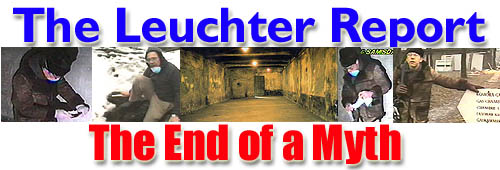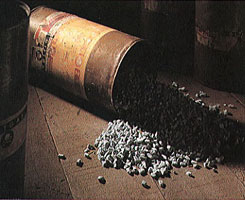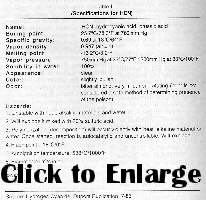
USE OF HCN AND ZYKLON B AS A FUMIGANT
 Zyklon B : A commonly used pesticide
Zyklon B : A commonly used pesticide
Hydrogen cyanide gas (HCN or hydrocyanic acid) has been utilized as
a fumigant since before WWI. It has been used side by side with steam and
hot air and during WWII with D.D.T. by the United States and its Allies.
HCN is generally manufactured by a chemical reaction of sodium cyanide
with dilute sulfuric acid. The chemical reaction results in HCN being given
off into the air with a remainder of prussic acid (hydrocyanic acid). This
reaction is normally contained in a ceramic crock pot.
This procedure has been utilized for pest and vermin control on ships,
in buildings and in specially designed chambers and structures. Special
design and handling considerations must be followed to ensure the safety
of the users (technicians). Hydrogen cyanide is one of the most powerful
and dangerous of all fumigation chemicals. Buildings especially constructed
or modified for this purpose were used by all militaries and health organizations
throughout the world. HCN has been used everywhere for disease control;
specifically for plague and typhus i.e. rat, flea and lice control.
Special chambers were used since WWI in Europe and the United States.
Some of these chambers were used by the German Army in Europe before and
during WWII and much earlier by the United States Immigration Service at
Ellis Island, New York Harbor. Many of these fumigation chambers were made
for DEGESCH, a German firm located in Frankfurt am Main, Germany. During
the war, DEGESCH supervised the distribution of Zyklon B. DEGESCH presently
manufactures HCN.
Zyklon B was a special commercial preparation containing hydrocyanic
acid. The name "Zyklon B" was itself a trade name. HCN was prepared
at the factory and delivered in a form where the HCN was absorbed in a
porous carrier, either wood pulp or diatomaceous earth (chalk). It was
supplied either in discoids or snippets or pellets. This preparation was
sealed in an airtight can which required a special can opener. In this
form the HCN - Zyklon B was much safer and easier to handle. The resultant
Zyklon B gas was HCN.
The discoids, snippets or pellets had to be spread on the floor of
the area to be fumigated or utilized in a chamber which circulated and
heated the air within the chamber in excess of 78.3 degrees Fahrenheit
(25.7 degrees Centigrade). If used in buildings, ships, or tents to fumigate
trees and produce, the area must be heated to an excess of 78.3 degrees
Fahrenheit temperature, the boiling point of HCN. Failure to do this will
result in a much longer time to complete the fumigation. Fumigation takes
a minimum of 24 to 48 hours.
 After
the fumigation, the ventilation of the area must take a minimum of ten
hours, depending on the location (and volume), and longer if the building
has no windows or exhaust fans. The fumigated area must then be chemically
tested for the presence of gas before entering. Gas masks are sometimes
used, but are not safe and should not be used for more than ten (10) minutes.
A complete chemical suit must be worn to prevent skin poisoning. The warmer
the temperature and the drier the location, the faster and safer the handling
will be.
After
the fumigation, the ventilation of the area must take a minimum of ten
hours, depending on the location (and volume), and longer if the building
has no windows or exhaust fans. The fumigated area must then be chemically
tested for the presence of gas before entering. Gas masks are sometimes
used, but are not safe and should not be used for more than ten (10) minutes.
A complete chemical suit must be worn to prevent skin poisoning. The warmer
the temperature and the drier the location, the faster and safer the handling
will be.
The specifications for the gas are found in Table
1.
Continue on to Design
Criteria for a Fumigation Facility



 After
the fumigation, the ventilation of the area must take a minimum of ten
hours, depending on the location (and volume), and longer if the building
has no windows or exhaust fans. The fumigated area must then be chemically
tested for the presence of gas before entering. Gas masks are sometimes
used, but are not safe and should not be used for more than ten (10) minutes.
A complete chemical suit must be worn to prevent skin poisoning. The warmer
the temperature and the drier the location, the faster and safer the handling
will be.
After
the fumigation, the ventilation of the area must take a minimum of ten
hours, depending on the location (and volume), and longer if the building
has no windows or exhaust fans. The fumigated area must then be chemically
tested for the presence of gas before entering. Gas masks are sometimes
used, but are not safe and should not be used for more than ten (10) minutes.
A complete chemical suit must be worn to prevent skin poisoning. The warmer
the temperature and the drier the location, the faster and safer the handling
will be.